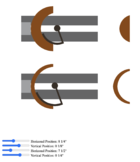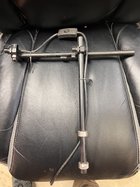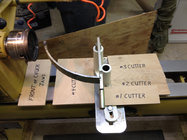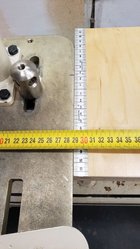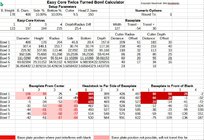This is a progress update. Easy-Core Calculator had been tested twice turned cores and the performance of the calculator was sufficient. Just finished my first once turned natural edge bowl set. I would call it a success though there were some minor issue.
The material was a Bradford Pear log, kind of old been sitting around, was about 13” in diameter and about 14” long. I was successful in getting 6 cores from that though the outside bowl core was junk because of cracks from the log end.
The calculator setup was for 10mm (0.4”) sides and a bottom that varied from 12mm to 22mm (0.47” to 0.87”). The capability of varying the bottom with size was added as I figured larger cores would need larger tenons, the calculator interpolates the bottom thickness from small to large. All that is user specified.
Here are the initial cores(minus the 6th):
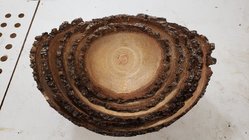
Here are the finished bowls:
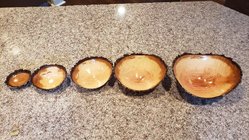
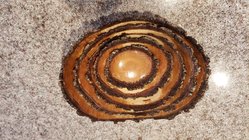
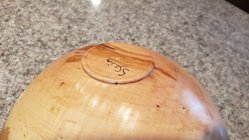 Performance
Performance
The core calculations versus the resulting cored:
| Side | Bottom | Cored Side | Cored Bottom | Delta Side | Delta Bottom |
Bowl 1 | 10.00 | 24.00 | NA | 23 | | -1 |
Bowl 2 | 10.00 | 20.00 | 10.5 | 16 | 0.5 | -4 |
Bowl 3 | 10.00 | 18.00 | 9.5 | 17 | -0.5 | -1 |
Bowl 4 | 10.00 | 16.00 | 8 | 12.5 | -2 | -3.5 |
Bowl 5 | 10.00 | 14.00 | 9.5 | 14 | -0.5 | 0 |
Bowl 6 | 10.00 | 12.00 | NA | | | |
Most of the numbers are pretty good. The problem area was the thickness of the core for Bowl 4 both side and bottom. That caused Bowl 4 to be pretty thin. The other number off was for Bowl 2 and I think that was caused by raising the cutter a bunch to get it finished with my binding knife 4 support.
The Bowl 4 issue was caused by a bad number for the radius of knife 1. Bowl 5 was cored with knife 1 and Bowl 4 used knife 2. The knife1 radius parameter was 2mm too low. I have corrected that and assume next time will be better.
Lesson learned, measure knife radius carefully.
I went back and remeasured everything. Yours might be different so best if you measure and set before using the calculator.
Once Turned Coring Procedure
Bowls 6 and 5 used knife 1, Bowl 4 used knife 2, Bowl 3 used knife 3 and Bowl 2 used knife 4.
For Bowl 2 and 3 cores a small step (mortise) was cut in the interior before coring so the bowl could be chucked to turn the outside and make a tenon. I think that could be done with the smaller ones too, just did not think of it at first. The step has to be shallow as there is not much wall thickness.
Each core had a small tenon, smaller in diameter than I would prefer, but it worked. Once the bowl was turned it was vacuum or jam chucked to turn the tenon into a foot.
Feel free to comment, offer suggestions, discuss etc.
Not ready to make public yet but think it is ready for outside testing. I am reasonably confident it works sufficiently well. All I am asking of testers is feedback on use, documentation, issues, suggestions.
Send me a message if your interested.
--sdc

